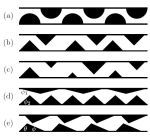EPJ B Colloquium - Heat flux anomaly at nanoscale
- Details
- Published on 21 October 2012

Nanomaterials are promising platforms for testing fundamental heat transport theories, according to a recent review outlining anomalous heat transport in nanometric scale materials.
The latest developments in experimental, theoretical and numerical studies of heat conduction have recently been published in EPJB. A review article by Singaporean and Chinese experts indicates that the standard laws governing conduction at macroscopic scale no longer apply in nanostructures. Instead, thermal conductivity is dependent on the material scale. Heat transport in nanoscale materials has implications in electronic, optoelectronic, and thermal devices.Nanostructures are low-dimensional materials such as single carbon atom layers of graphene, nanowires or nanotubes. Laws governing heat transport through what are known as phonons, representing the vibrational modes of lattices, are different in such materials compared to the macroscopic scale. This is because the phonon characteristic lengths are comparable to the characteristic lengths of these nanostructures. Particularly, heat carriers diffuse faster than in a random walk but slower than in a straight trajectory motion.
This paper outlines the recent experiments on quasi-one-dimensional nanostructures and two-dimensional graphene that display a thermal conductivity with this anomalous behaviour, linked to heat diffusion’s size dependency. Such studies present a dual challenge in that the technique associated with measuring heat flux in nanosystems is combined with the complexity of accurately controlling object at nanoscale. Due to these measurement challenges, experimental results need to be complemented by theoretical studies. Hence, this paper also accounts for numerical studies on heat conduction of nanotubes, nanowires and graphene, concentrating particularly on atomic-level simulations.
In addition, the latest theories explaining the mechanisms of such anomalous heat conduction are presented. But these are by no means complete. Further systematic investigations are needed for better thermal energy management and control in nanoscale devices.
Anomalous heat conduction and anomalous diffusion in low dimensional nanoscale systems. S. Liu et al., Eur. Phys. J. B (2012) 85: 337, DOI: 10.1140/epjb/e2012-30383-8




